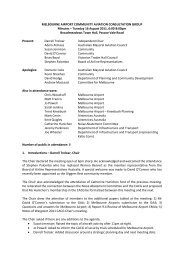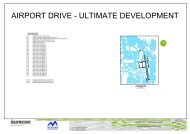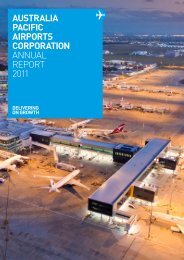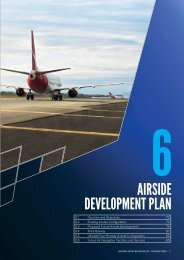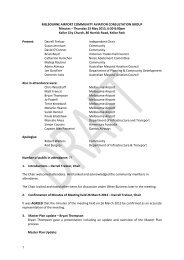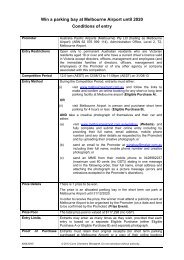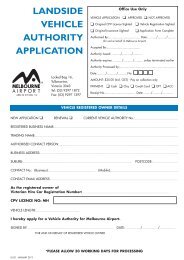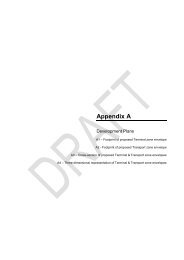Section 9 - Ground Transport Plan - Melbourne Airport
Section 9 - Ground Transport Plan - Melbourne Airport
Section 9 - Ground Transport Plan - Melbourne Airport
You also want an ePaper? Increase the reach of your titles
YUMPU automatically turns print PDFs into web optimized ePapers that Google loves.
9.8.6 Rail<br />
In 10 years, <strong>Melbourne</strong> <strong>Airport</strong> will be serving more than<br />
40 million passengers a year. A rail link is expected to<br />
carry more than six million passengers a year, or the<br />
equivalent of more than 11,000 private vehicle trips<br />
a day, delivering major productivity improvements and<br />
environmental benefits.<br />
A new heavy rail link is proposed to provide access to<br />
the terminals precinct. The services will be frequent and<br />
reliable, with high-quality interchange facilities closely<br />
connected with the terminals. <strong>Melbourne</strong> <strong>Airport</strong> is aiming<br />
to increase all trips to the airport by public transport by<br />
2022 to 15–25 per cent, making the rail link vital. In the<br />
long term, <strong>Melbourne</strong> <strong>Airport</strong> seeks public transport<br />
usage of no less than 30 per cent.<br />
The Victorian Government identified a corridor for a rail<br />
link to the airport in the Environmental Impact Study<br />
undertaken as part of the <strong>Melbourne</strong> <strong>Airport</strong> Strategy<br />
1990, and reserved land for the rail link in May 2005.<br />
Over the past five years, the former Department of<br />
<strong>Transport</strong> (now the Department of <strong>Transport</strong>, <strong>Plan</strong>ning<br />
and Local Infrastructure), Public <strong>Transport</strong> Victoria and<br />
<strong>Melbourne</strong> <strong>Airport</strong> have worked together to refine the<br />
proposed rail corridor. These efforts have reduced the<br />
length of the proposed underground rail from previous<br />
proposals. This refined corridor was considered as part<br />
of the new elevated road network development. The<br />
corridor is consistent with the Albion-East alignment<br />
which was identified as the best route for a <strong>Melbourne</strong><br />
<strong>Airport</strong> Rail Link by the State Government.<br />
The rail link corridor will be accommodated within the<br />
central reserve of the new road link along <strong>Airport</strong> Drive,<br />
continuing from Mercer Drive to a station in the main<br />
terminal precinct. According to the proposal, the corridor<br />
will continue to be refined with Public <strong>Transport</strong> Victoria<br />
to ensure its viability. The goal is to preserve the options<br />
of above-ground, ground-level and below-ground systems<br />
wherever possible. Under the ultimate plan for airport<br />
expansion, new rail links would be considered to link any<br />
new terminals where travel distances become onerous.<br />
9.8.7 Taxi/VHA<br />
Many of the road improvements outlined in this Master<br />
<strong>Plan</strong> will increase the capability of the taxi system to<br />
move large numbers of passengers. Within the life of<br />
this plan and beyond, specific influences will impact<br />
on current operating systems, particularly in relation<br />
to security requirements.<br />
9.8.8 Freight<br />
The local road network, particularly within airport land,<br />
will have local access roads created as the business park<br />
develops, including the freight terminal area. These will<br />
be constructed to standards that maximise efficiency,<br />
particularly freight movement. <strong>Airport</strong> Drive and the<br />
elevated loop road will reduce intersection conflict and<br />
congestion and have roads that accommodate freight<br />
transport. Within the next 20 years but following this<br />
Master <strong>Plan</strong>, there will be refinements to the elevated loop<br />
road and <strong>Airport</strong> Drive will be upgraded to six lanes.<br />
On the external road network, the additional lane on the<br />
Tullamarine Freeway and the Bulla Bypass Road will<br />
provide valuable capacity to move freight into and from<br />
the airport.<br />
9.8.9 Demand Management<br />
As the airport grows, the need to roll out initiatives to<br />
encourage people to use high-occupancy vehicles or<br />
walk or cycle becomes increasingly important. Each will<br />
be embraced as detailed in the relevant section of the<br />
Master <strong>Plan</strong>. Technology and communications will also<br />
be developed to improve existing network capability.<br />
DRAFT<br />
A partnership between <strong>Melbourne</strong> <strong>Airport</strong> and<br />
Commonwealth, State and local governments and private<br />
sector operators is expected to support infrastructure<br />
planning and delivery.<br />
9.8.10 Active <strong>Transport</strong><br />
Following on from the completion of the <strong>Airport</strong> Drive<br />
shared path within the life of this Master <strong>Plan</strong>, the Outer<br />
Metropolitan Ring <strong>Transport</strong> Corridor and the Bulla<br />
Bypass projects will be planned, with the latter likely to<br />
commence construction within the life of this plan. The<br />
Bulla Bypass project will see an extension of the off-road<br />
bicycle paths that will enable greater safety on Sunbury<br />
Road, a component of the Principal Bicycle Network.<br />
In addition, during this period the lower road network will<br />
be significantly refined as a result of shifting traffic from<br />
existing roads to the elevated loop road. ‘On road’ paths<br />
will become viable and will be developed. This will<br />
reinforce the connection to other existing active transport<br />
facilities and establish more flexible to internal<br />
movements.<br />
132




